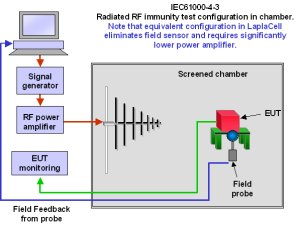RELIANT EMC PRODUCT LINES
MANUFACTURERS
EMC IEC61000-4-3 RADIATED IMMUNITY TESTING
Radiated RF Immunity IEC61000-4-3 immunity testing requires that the EUT (equipment under test) operates satisfactorily when subject to a strong radiated electromagnetic field. (Such as might be created by cell phones and other intentional radiators, and RF noise that might be caused, inadvertently or otherwise, by industrial processes). This requires a frequency scan at a certain fixed level of field strength (specified by the standard). The ‘scan’ will comprise a series of ‘steps’ in frequency. Each step is specified as a percentage of current frequency value. This percentage is variable from 0.2% to 5%. At each step, the frequency is held, the level adjusted to the required field strength (V/m) as measured by a field sensor, a prescribed modulation mode is initiated and then the conditions held for a ‘dwell’ time. The EUT should be monitored to detect faulty operation during the test. Typical values for field strength are 3 V/m for domestic and 10 V/m for industrial products. Other higher stress levels are often specified for certain types of products eg medical and automotive. These fields are so intense that this test must be carried out in a screened chamber or test cell. Test cells such as the GTEM or Laplacell are highly efficient but restricted to small products. Screened chambers can be large, but can be relatively expensive and require powerful amplifiers to create the required stress levels.
So the equipment required for this type of test comprises:
- Signal generator (synthesizer)
- Power amplifier
- Antenna
- Field probe
- Control software and PC
- EUT monitoring system
- Test cell or chamber

In particular, the range of LaplaCells not only provides an economical and efficient alternative to the test chamber, it also provides a calibrated environment for radiated emissions measurements.
EMC EMISSION TESTING PRODUCTS
IEC61000-4-3 TESTING PRODUCTS
- EMC Test Design Smart Fieldmeter RFP 4CE
- Laplace Instruments LaplaCell
- Laplace Instruments LETIS (Laplace EMC Test Integration System)
- Laplace Instruments SA1002 1Ghz Spectrum Analyzer
- Laplace Instruments SA3000 3Ghz Spectrum Analyzer
- Laplace Instruments ERS (Emission Reference Source)
- Laplace Instruments RF200 Broadband EMC Log Periodict Antenna
- Laplace Instruments RF230 Broadband EMC Log Periodict Antenna
- Laplace Instruments RF600 FM Band Filter
- Laplace Instruments RF700 30Mhz High Pass Filter
- Laplace Instruments Conductive Comb Generators
- Eurofins York ARA01KIT01 Small Active Receive Antenna
- Eurofins York CNE Comparison Noise Emitters
